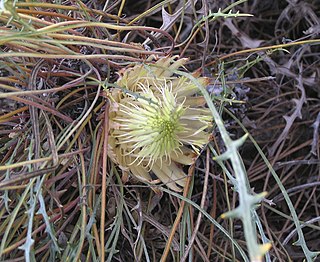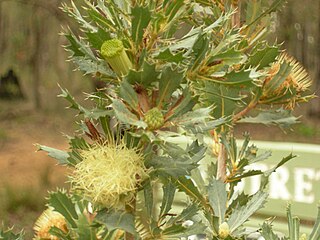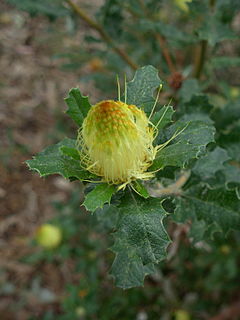
Banksia subg. Banksia is a valid botanic name for a subgenus of Banksia. As an autonym, it necessarily contains the type species of Banksia, B. serrata. Within this constraint, however, there have been various circumscriptions.

Banksia sessilis, commonly known as parrot bush, is a species of shrub or tree in the plant genus Banksia of the family Proteaceae. It had been known as Dryandra sessilis until 2007, when the genus Dryandra was sunk into Banksia. The Noongar peoples know the plant as budjan or butyak. Widespread throughout southwest Western Australia, it is found on sandy soils over laterite or limestone, often as an understorey plant in open forest, woodland or shrubland. Encountered as a shrub or small tree up to 6 m (20 ft) in height, it has prickly dark green leaves and dome-shaped cream-yellow flowerheads. Flowering from winter through to late spring, it provides a key source of food—both the nectar and the insects it attracts—for honeyeaters in the cooler months, and species diversity is reduced in areas where there is little or no parrot bush occurring. Several species of honeyeater, some species of native bee, and the European honey bee seek out and consume the nectar, while the long-billed black cockatoo and Australian ringneck eat the seed. The life cycle of Banksia sessilis is adapted to regular bushfires. Killed by fire and regenerating by seed afterwards, each shrub generally produces many flowerheads and a massive amount of seed. It can recolonise disturbed areas, and may grow in thickets.

Banksia acanthopoda is a species of shrub in the family Proteaceae. It grows as a small spreading shrub to 2 m high and has prickly leaves and yellow composite flower heads, called inflorescences, composed of 50 to 60 individual yellow flowers. Flowering takes place in the southern hemisphere winter. Endemic to Western Australia, it occurs only in a few populations in the vicinities of Woodanilling, Katanning and Darkan. Because of its rarity, it is classed as "Priority Two" conservation flora by Western Australia's Department of Environment and Conservation.

Banksia rufa is a species of prostrate shrub that is endemic to the south-west of Western Australia. It has broadly linear, pinnatifid or pinnatipartite leaves with between five and twenty lobes on each side, yellow, orange or brownish flowers in heads of forty or more, and glabrous, egg-shaped follicles.

Banksia dallanneyi, commonly known as couch honeypot, is a species of prostrate shrub that is endemic to Western Australia. It only has a short above-ground stem, pinnatipartite or pinnatisect leaves, between thirty and seventy variously coloured flowers and glabrous, egg-shaped fruit.

Banksia nobilis, commonly known as the golden dryandra, great dryandra or kerosene bush, is a shrub of the family Proteaceae which is endemic to Western Australia. It occurs on lateritic rises from Eneabba to Katanning in the state's Southwest Botanic Province. With large pinnatifid leaves with triangular lobes, and a golden or reddish pink inflorescence, it is a popular garden plant. It was known as Dryandra nobilis until 2007, when all Dryandra species were transferred to Banksia by Austin Mast and Kevin Thiele. There are two subspecies, B. nobilis subsp. nobilis and B. nobilis subsp. fragrans.

Alex George's taxonomic arrangement of Banksia was the first modern-day arrangement for that genus. First published in 1981 in the classic monograph The genus Banksia L.f. (Proteaceae), it superseded the arrangement of George Bentham, which had stood for over a hundred years. It was overturned in 1996 by Kevin Thiele and Pauline Ladiges, but restored by George in 1999. A recent publication by Austin Mast and Kevin Thiele suggests that it will soon be overturned again.
Robert Brown's taxonomic arrangement of Dryandra was the first arrangement of what is now Banksia ser. Dryandra. His initial arrangement was published in 1810, and a further arrangement, including an infrageneric classification, followed in 1830. Aspects of Brown's arrangements can be recognised in the later arrangements of George Bentham and Alex George.

George Bentham's taxonomic arrangement of Dryandra was published in 1870, in Volume 5 of Bentham's Flora Australiensis. It replaced the 1856 arrangement of Carl Meissner, and stood for over a century before being replaced by the 1996 arrangement of Alex George.
Carl Meissner's taxonomic arrangement of Dryandra, now Banksia ser. Dryandra, was published in 1856 as part of his chapter on the Proteaceae in A. P. de Candolle's Prodromus systematis naturalis regni vegetabilis. It replaced the 1830 arrangement of Robert Brown, and remained current until superseded by the 1870 arrangement of George Bentham.
Dryandra ser. Niveae is an obsolete series within the former genus Dryandra. It was first published by George Bentham in 1870, and was given a new circumscription by Alex George in 1996, but was ultimately discarded in 2007 when Austin Mast and Kevin Thiele sunk Dryandra into Banksia.

Dryandra subg. Dryandra is an obsolete clade of plant. It was a series within the former genus Dryandra. The name was first published at sectional rank as Dryandra verae in 1830, before being renamed Eudryandra in 1847, the replaced by the autonym at subgenus rank in 1996. It was ultimately discarded in 2007 when Austin Mast and Kevin Thiele sunk Dryandra into Banksia.

Dryandra ser. Floribundae is an obsolete series within the former genus Dryandra. It was first published by George Bentham in 1870, and was given a new circumscription by Alex George in 1996, but was ultimately discarded in 2007 when Austin Mast and Kevin Thiele sunk Dryandra into Banksia.

Dryandra ser. Armatae is an obsolete series within the former genus Dryandra. It was first published by George Bentham in 1870, and was given a new circumscription by Alex George in 1996, but was ultimately discarded in 2007 when Austin Mast and Kevin Thiele sunk Dryandra into Banksia.

Dryandra ser. Ilicinae is an obsolete series within the former genus Dryandra. It was first published by Carl Meissner in 1856, but was discarded by George Bentham in 1870. It was reinstated with a new circumscription by Alex George in 1996, but was ultimately discarded again in 2007 when Austin Mast and Kevin Thiele sunk Dryandra into Banksia.
Dryandra ser. Plumosae is an obsolete series within the former genus Dryandra. It was published by Alex George in 1996, but discarded in 2007 when Austin Mast and Kevin Thiele sank Dryandra into Banksia.

Dryandra ser. Aphragma is an obsolete series within the former genus Dryandra. It was first published at sectional rank by Robert Brown in 1830, and was retained at that rank until 1999, when Alex George demoted it to a series. It was discarded in 2007 when Austin Mast and Kevin Thiele sank Dryandra into Banksia.













